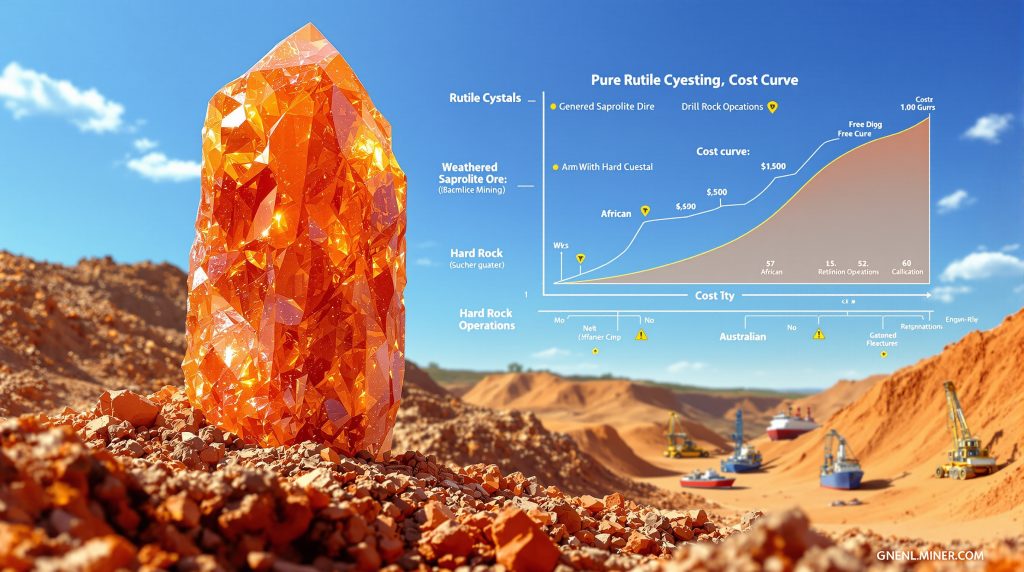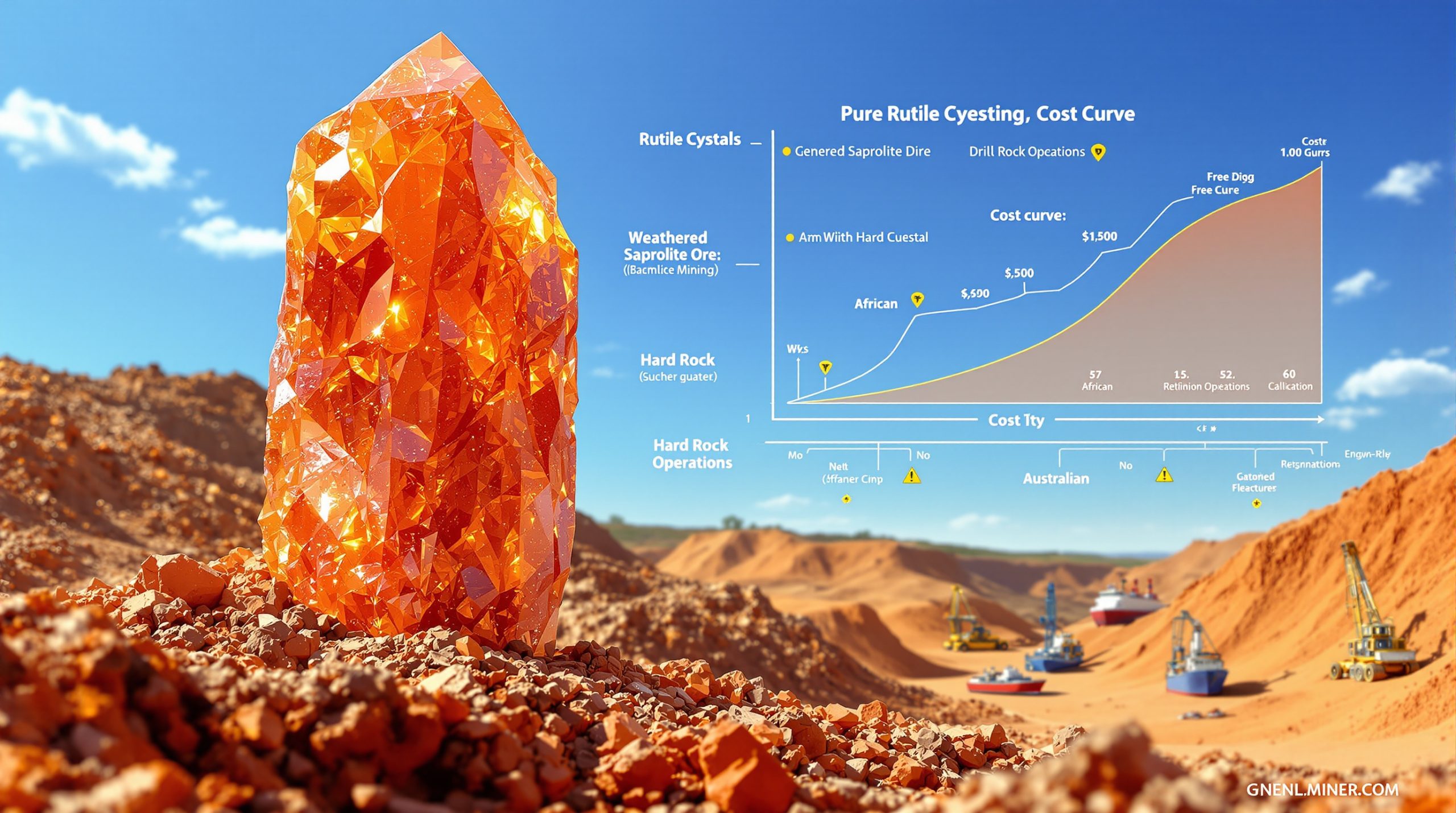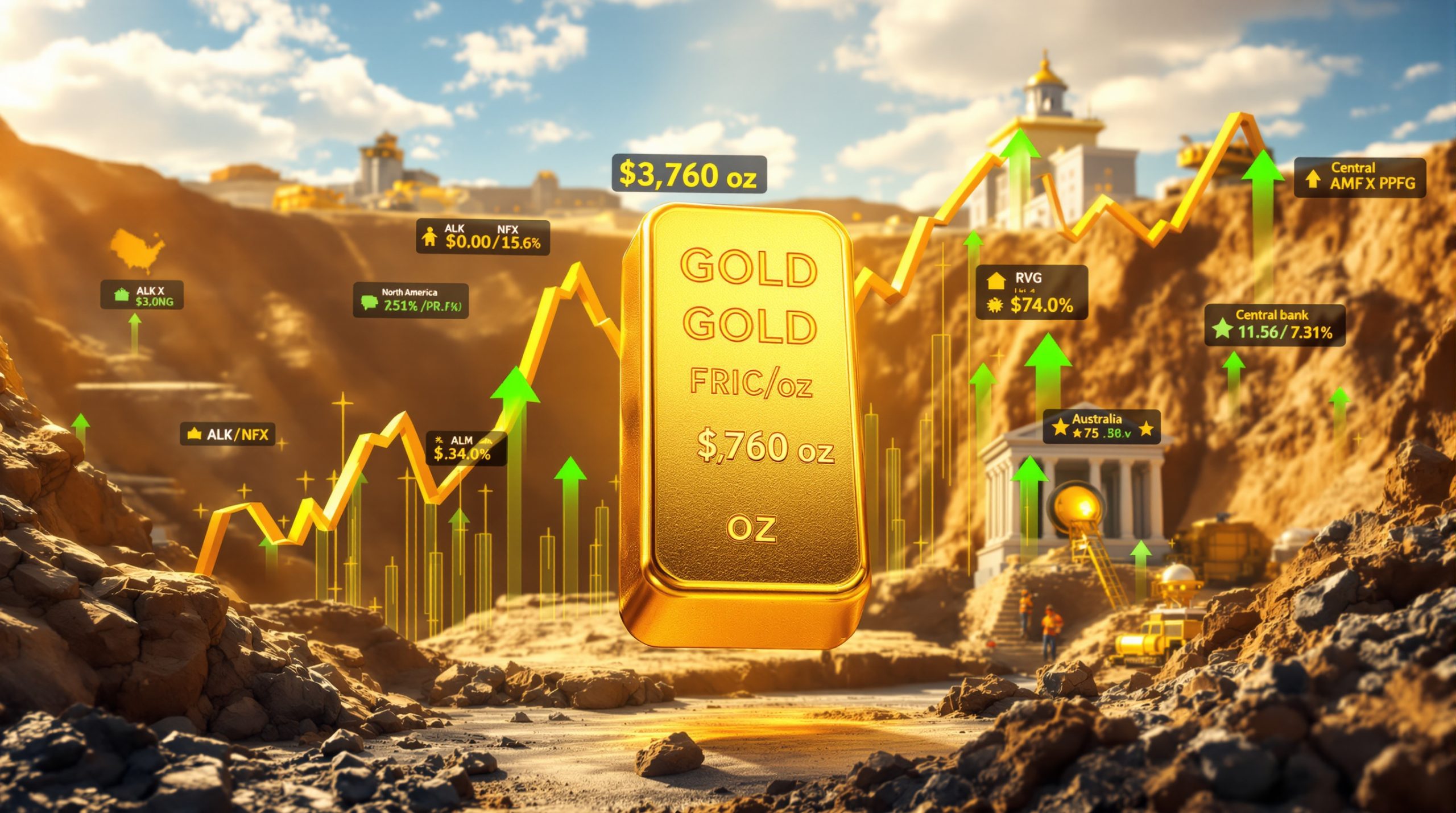Understanding Rutile Supply Constraints and Production Economics
Natural rutile markets face increasing pressure from supply constraints and changing production economics, creating both challenges and opportunities for industry participants. This analysis examines the structural factors driving rutile supply tightness, the economics of different production approaches, and the strategic value of low-cost projects in today's market environment.
What Are the Current Global Rutile Supply Challenges?
Legacy Mine Depletion Creating Structural Supply Gap
Natural rutile supply faces significant pressure from the depletion of established deposits, particularly in Africa. The closure of Base Resources' Kwale mine in Kenya has removed approximately 90,000 tonnes per annum from global supply, creating an immediate gap in market availability. Other aging African operations struggle with declining ore grades, deeper mining benches, and rising strip ratios that limit economic expansion potential.
These factors reflect the maturity of established rutile provinces and highlight the difficulty of replacing depleted tonnage with new discoveries. As high-grade, easily accessible deposits become scarcer, the industry faces mounting challenges in maintaining supply levels to meet ongoing demand.
Operational Suspensions Amplifying Market Tightness
Australian supply dynamics add complexity to the global rutile balance. Iluka Resources recently announced the suspension of its Cataby mine for approximately 12 months and halted its Synthetic Rutile Kiln SR2 for roughly six months. These actions, while responding to near-term demand conditions, demonstrate the sensitivity of high-cost producers to margin compression and the extended lead times required to restart idled capacity.
The combined effect of these suspensions temporarily removes significant volume from an already constrained market. Unlike commodity markets with rapid supply responsiveness, rutile production cannot be quickly ramped up once suspended, creating lag effects that extend supply tightness beyond demand recovery periods.
Price Stability Signaling Structural Supply Constraints
Despite weak downstream demand in titanium dioxide and pigment markets, rutile export prices have remained anchored in the $1,825-1,900 per tonne range. This price stability amid soft end-use markets indicates that supply constraints, rather than robust demand, are supporting price levels.
The rutile market now operates with limited transparency following the discontinuation of reliable pricing indices, with bilateral contracts and opaque spot trades dominating price discovery mechanisms. This opacity creates information asymmetries that favor established suppliers with long-term relationships and consistent production histories.
How Do Production Costs Vary Across Different Rutile Projects?
Geology as the Primary Cost Driver
Production costs vary dramatically based on geological setting, with weathered deposits offering significant economic advantages over hard-rock alternatives:
| Deposit Type | Mining Method | Processing Requirements | Typical Cost Position |
|---|---|---|---|
| Weathered Saprolite | Free-dig extraction | Simple gravity separation | Bottom quartile |
| Mineral Sands | Dredging or dry mining | Multiple separation stages | Mid-tier |
| Hard Rock | Drill and blast | Crushing, grinding, complex separation | Upper quartile |
Weathered saprolite deposits eliminate conventional mining costs associated with drilling, blasting, crushing, and grinding. The soft, friable nature of the ore allows for free-dig extraction, reducing equipment requirements and energy consumption. This geological advantage translates directly to lower operating costs and simplified processing flowsheets.
Byproduct Economics Creating Cost Advantages
Projects producing rutile alongside other minerals benefit from byproduct cost allocation that improves overall economics:
-
Single-commodity operations must recover all costs from rutile revenue alone
-
Dual-commodity projects can distribute costs across multiple revenue streams
-
Integrated producers capture additional margin through downstream processing
For example, operations that recover rutile alongside ilmenite, zircon, or graphite can allocate shared mining and processing costs across multiple products. This cost-sharing mechanism creates resilience against price volatility in any single commodity and positions multi-commodity producers more favorably on the global cost curve.
Jurisdictional Factors Impacting Total Production Costs
Beyond geology and processing requirements, jurisdictional factors significantly influence total production costs:
-
Energy costs vary by up to 300% between low-cost and high-cost jurisdictions
-
Labor productivity and costs create competitive advantages or disadvantages
-
Regulatory compliance expenses add 5-15% to operating costs in stringent jurisdictions
-
Infrastructure access determines logistics efficiency and transportation costs
Projects in regions with established infrastructure, stable energy supplies, and transparent regulatory frameworks typically achieve lower delivered costs to market compared to operations in remote or challenging jurisdictions.
Why Are Low-Cost Rutile Projects Increasingly Valuable?
Market Structure Rewarding Cost Leadership
The rutile market structure increasingly rewards low-cost producers as price volatility and supply uncertainty become more pronounced:
-
Price-taking environment where individual producers have limited pricing power
-
Bilateral contract dominance creating information asymmetries
-
Opaque spot markets with limited price discovery mechanisms
-
Increasing buyer preference for reliable, long-term supply partners
In this environment, projects positioned in the bottom quartile of the cost curve maintain profitability across price cycles and attract premium offtake arrangements. Cost leadership provides negotiating leverage in contract discussions and supports investment returns even during periods of market weakness.
Strategic Value Premium for Secure Supply
Beyond pure economics, rutile projects in stable jurisdictions command strategic value premiums:
-
Supply chain security concerns driving diversification strategies
-
ESG compliance requirements increasing importance of transparent operations
-
Geopolitical risk mitigation through jurisdictional diversification
-
Long-term partnership potential with downstream consumers
End users increasingly prioritize supply security and sustainability over marginal cost advantages, creating valuation premiums for projects that combine cost competitiveness with jurisdictional stability and mine planning and ESG alignment.
What Are the Key Economic Metrics for Evaluating Rutile Projects?
Capital Intensity Benchmarks
Capital intensity varies significantly across rutile projects based on scale, complexity, and infrastructure requirements:
| Project Scale | Typical Capital Intensity ($/annual tonne) | Development Timeline |
|---|---|---|
| Small-scale (<50ktpa) | $3,000-5,000 | 2-3 years |
| Medium-scale (50-100ktpa) | $2,500-3,500 | 3-4 years |
| Large-scale (>100ktpa) | $2,000-3,000 | 4-5+ years |
Lower capital intensity projects typically generate superior returns on invested capital and reach production milestones more rapidly. Projects with staged development approaches can reduce initial capital requirements while preserving expansion optionality, improving risk-adjusted returns.
Operating Cost Structure Analysis
Understanding the operating cost structure provides insight into project resilience and margin potential:
-
Mining costs typically represent 30-40% of total operating expenses
-
Processing costs account for 35-45% of the cost structure
-
General and administrative expenses add 10-15%
-
Transportation and logistics contribute 10-20% depending on location
Projects with favorable mining conditions (low strip ratios, free-dig material) and simple processing requirements maintain cost advantages throughout their operational life. Additionally, operations with access to low-cost energy and efficient logistics infrastructure achieve sustainable competitive advantages.
Margin Sustainability Through Price Cycles
Margin sustainability through price cycles represents a critical evaluation metric:
-
All-in sustaining cost (AISC) provides a comprehensive view of operational economics
-
Breakeven price indicates resilience to market downturns
-
Margin buffer determines ability to withstand price volatility
-
Reinvestment requirements impact long-term cost position
Projects with substantial margins above AISC maintain financial flexibility during market downturns and generate sufficient cash flow to fund ongoing capital requirements without additional financing.
How Do Rutile Supply Constraints Impact Market Dynamics?
Price Formation in Constrained Markets
Supply constraints fundamentally alter price formation mechanisms in the rutile market:
-
Floor price establishment based on marginal producer economics
-
Supply-driven pricing rather than demand-responsive adjustments
-
Contract premium development for secure, long-term supply
-
Quality differentiation becoming more pronounced
As supply tightness persists, buyers increasingly differentiate between reliable and unreliable sources, creating a two-tier market with premium pricing for consistent, high-quality material from stable jurisdictions.
Offtake Strategies Evolving Under Constraints
Supply constraints have transformed offtake strategies across the value chain:
-
Longer contract durations replacing spot market reliance
-
Take-or-pay provisions becoming more common
-
Price floors and collars replacing pure floating price mechanisms
-
Strategic investments in mining projects by end users
Downstream consumers increasingly seek direct involvement in upstream supply to secure volume allocations and mitigate price risk. This trend favors projects capable of delivering large-scale, consistent production over multi-decade operational lives.
Substitution Economics Under Supply Pressure
Supply constraints influence substitution economics across titanium feedstock markets:
-
Synthetic rutile production growing at 3-4% compound annual rate
-
Chloride slag partially substituting for natural rutile in some applications
-
Process adaptations to accommodate alternative feedstocks
-
Technical limitations preventing complete substitution
While substitution provides partial relief from supply constraints, technical requirements in high-performance applications maintain demand for natural rutile. The higher energy inputs and carbon dioxide emissions associated with synthetic alternatives also create ESG considerations that support natural rutile demand.
What Are the Future Trends in Rutile Production Economics?
Technology Innovations Reshaping Cost Structures
Emerging technologies are reshaping rutile supply constraints and production costs:
-
Sensor-based sorting reducing processing costs by 10-15%
-
Automation and remote operations improving labor productivity
-
Energy efficiency improvements lowering power consumption
-
Alternative reagent development reducing chemical costs
These innovations disproportionately benefit greenfield projects designed to incorporate advanced technologies from inception, potentially reshaping the global cost curve as new capacity enters production.
ESG Compliance Costs Becoming Material
Environmental, social, and governance compliance costs are becoming material factors in project economics:
-
Carbon pricing mechanisms adding $5-15 per tonne to high-emission operations
-
Water management requirements increasing capital and operating expenses
-
Community development obligations growing in scale and scope
-
Closure and rehabilitation provisions requiring larger financial assurances
Projects designed with ESG considerations integrated from inception typically achieve lower compliance costs compared to operations retrofitting solutions to existing infrastructure. This creates a competitive advantage for new, purpose-designed projects with strong sustainability credentials.
Vertical Integration Creating New Economic Models
Vertical integration strategies are creating new economic models in the rutile value chain:
-
Mine-to-pigment integration capturing additional margin
-
Specialty product development targeting premium applications
-
Closed-loop recycling systems recovering titanium from waste streams
-
Custom product specifications meeting specific customer requirements
These integrated approaches create opportunities to capture additional value beyond commodity rutile production, potentially transforming project economics through higher realized prices and improved margin stability.
How Can Investors Evaluate Rutile Project Potential?
Key Technical Differentiation Factors
Technical differentiation factors provide insight into project quality and competitive positioning:
-
Resource grade and continuity determining mining efficiency
-
Mineralogical characteristics influencing recovery rates
-
Impurity profiles affecting product marketability
-
Expansion potential supporting long-term growth
Higher-grade deposits with consistent mineralization, favorable recovery characteristics, and low impurity levels typically achieve superior economic outcomes. Projects with substantial resource upside also command valuation premiums due to optionality value.
Development Timeline Realism
Development timeline realism significantly impacts project valuation:
-
Permitting pathway complexity determining regulatory timeframes
-
Infrastructure requirements influencing construction schedules
-
Technical complexity affecting ramp-up periods
-
Financing requirements potentially creating timeline dependencies
Projects with clear, realistic development pathways and manageable technical risks achieve higher confidence ratings from investors and secure more favorable financing terms. Conversely, projects with uncertain permitting outcomes or complex technical challenges face valuation discounts.
Strategic Positioning Assessment
Strategic positioning within the broader market provides context for investment decisions:
-
Market entry timing relative to supply-demand balance
-
Competitive landscape evolution during development period
-
Customer relationship potential based on product specifications
-
Strategic partnership opportunities with downstream consumers
Projects positioned to enter production during periods of market tightness typically achieve superior initial returns and establish stronger customer relationships. Similarly, operations capable of producing differentiated products or serving specific market segments may capture premium pricing.
How Are Rutile Production Costs Calculated?
Component-Based Cost Analysis
Rutile production costs are calculated using a component-based analysis that captures all expenses associated with mining, processing, and delivering product to market:
Mining Costs
-
Overburden removal – Expenses related to removing non-mineralized material
-
Ore extraction – Direct costs of mining mineralized material
-
Grade control – Sampling and analysis to manage ore quality
-
Equipment operation – Fuel, maintenance, and operator costs
-
Mine planning and supervision – Technical and management oversight
Mining costs vary dramatically based on deposit characteristics, with free-dig operations achieving costs 40-60% lower than conventional drill-blast-load-haul operations in hard rock settings.
Processing Costs
-
Material handling – Conveying and stockpile management
-
Size reduction – Crushing, grinding, or disaggregation
-
Separation – Physical and chemical concentration methods
-
Drying and finishing – Final product preparation
-
Quality control – Testing and certification
Processing complexity directly influences cost structure, with simple gravity separation methods typically costing 30-50% less than complex multi-stage concentration circuits required for more challenging ores.
Site Support Costs
-
Administration – Management and office expenses
-
Environmental management – Monitoring and compliance costs
-
Maintenance infrastructure – Workshops and support facilities
-
Camp and accommodation – For remote operations
-
Security and safety – Protection of assets and personnel
Site support costs vary based on location, scale, and operational complexity, typically representing 10-15% of total operating expenses.
Logistics and Marketing Costs
-
Site to port transportation – Trucking, rail, or pipeline costs
-
Port handling and storage – Terminal fees and inventory costs
-
Ocean freight – Shipping to destination markets
-
Sales and marketing – Customer relationship management
-
Product liability insurance – Protection against claims
Logistics costs create significant competitive advantages or disadvantages based on infrastructure access and distance to market, with well-positioned operations achieving delivered costs 15-25% lower than remote or infrastructure-constrained alternatives.
What Factors Determine Rutile Project Economics?
Grade and Recovery Relationships
Grade and recovery relationships fundamentally determine project economics:
| Rutile Grade Range | Typical Recovery | Production Cost Impact |
|---|---|---|
| <1.0% | 60-70% | Higher costs due to processing more material |
| 1.0-1.5% | 70-80% | Moderate costs with standard processing |
| >1.5% | 80-90% | Lower costs due to processing efficiency |
Higher grades reduce the volume of material that must be mined and processed to produce each tonne of rutile, directly lowering unit costs. Similarly, higher recovery rates improve resource utilization and reduce the effective cost per recovered tonne.
Scale Economies and Optimization
Scale economies significantly influence unit costs across operations:
-
Fixed cost distribution across larger production volumes
-
Equipment utilization improvements at optimal scale
-
Procurement advantages through volume purchasing
-
Specialized personnel efficiency at appropriate scale
-
Infrastructure cost amortization over larger production base
Optimally sized operations typically achieve unit costs 20-30% lower than sub-scale alternatives, creating a structural advantage that persists throughout the project life.
Energy Intensity and Source Mix
Energy represents a significant cost component in rutile production:
-
Electricity consumption for processing equipment
-
Diesel fuel for mining and transportation
-
Natural gas or coal for drying and heating
-
Renewable integration potential for cost reduction
Operations with access to low-cost, reliable energy sources maintain substantial competitive advantages, particularly as carbon pricing mechanisms become more widespread. Projects incorporating renewable energy can achieve both cost advantages and improved ESG credentials.
Byproduct Revenue Contributions
Byproduct revenue significantly influences effective rutile production costs:
-
Ilmenite – Often co-produced with rutile in mineral sands
-
Zircon – High-value mineral frequently associated with rutile
-
Graphite – Present in some weathered rutile deposits
-
Rare earth elements – Occasional valuable constituents
Byproduct credits can reduce effective rutile production costs by 20-40% in favorable deposits, creating a structural advantage that persists regardless of rutile price movements. This advantage is particularly important when considering mineral beneficiation opportunities and the appropriate cut‐off grade significance for project development.
What Are the FAQ About Rutile Supply and Production Costs?
Why do rutile prices remain stable despite weak downstream demand?
Rutile prices remain stable despite weak downstream demand due to structural supply constraints rather than demand strength. The closure of legacy mines, operational suspensions, and limited new project development have created a supply-constrained environment where even modest demand is sufficient to support price levels.
The bilateral nature of most rutile contracts also creates price stickiness, with long-term agreements insulating prices from short-term demand fluctuations. This dynamic demonstrates that supply-side factors currently dominate price formation in the rutile market.
How do weathered deposits achieve lower production costs compared to mineral sands?
Weathered deposits achieve lower production costs compared to mineral sands through several mechanisms:
-
Elimination of energy-intensive crushing and grinding – Weathered material is naturally disaggregated
-
Simplified processing flowsheets – Fewer separation stages required
-
Lower reagent consumption – Less complex chemistry needed
-
Reduced equipment wear and maintenance – Softer material causes less abrasion
-
Higher mineral liberation – Improved recovery with less processing
These advantages collectively reduce both capital and operating costs, positioning weathered deposits favorably on the global cost curve. The understanding of deposit characteristics is greatly enhanced through proper drill results interpretation.
What determines the premium for rutile from stable jurisdictions?
The premium for rutile from stable jurisdictions reflects multiple factors:
-
Supply reliability – Consistent production without disruption
-
Regulatory predictability – Transparent and stable operating environment
-
ESG compliance – Adherence to international standards
-
Quality consistency – Reliable product specifications
-
Contract security – Enforceable legal frameworks
End users increasingly value these attributes as supply chain security becomes a strategic priority, creating willingness to pay premiums of 5-15% for material from stable jurisdictions with transparent regulatory frameworks. These market dynamics are part of the broader mining industry evolution occurring across the sector.
Disclaimer: This article contains forecasts and analyses of commodity markets that are subject to significant uncertainty. Economic conditions, regulatory changes, and market dynamics can cause actual outcomes to differ substantially from those predicted. Investment decisions should be made based on comprehensive due diligence rather than relying solely on market commentary.
Searching for the Next Mineral Discovery Opportunity?
Discover potentially transformative ASX mineral announcements the moment they happen with Discovery Alert's proprietary Discovery IQ model, providing you with actionable investment insights ahead of the market. Visit the dedicated discoveries page to explore why historic discoveries have generated substantial returns and begin your 30-day free trial today.




